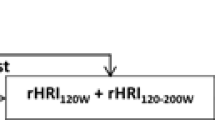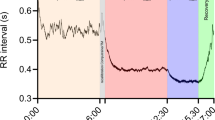Abstract
Purpose
Being able to identify how an athlete is responding to training would be useful to optimise adaptation and performance. The maximal rate of heart rate increase (rHRI), a marker of heart rate acceleration has been shown to correlate with performance changes in response to changes in training load in male athletes; however, it has not been established if it also correlates with performance changes in female athletes.
Methods
rHRI and cycling performance were assessed in six female cyclists following 7 days of light training (LT), 14 days of heavy training (HT) and a 10 day taper period. rHRI was the first derivative maximum of a sigmoidal curve fit to R-R data recorded during 5 min of cycling at 100 W. Cycling performance was assessed as work done (kJ) during time-trials of 5 (5TT) and 60 (60TT) min duration.
Results
5TT was possibly decreased at HT (ES ± 90% confidence interval = − 0.16 ± 0.25; p = 0.60), while, 5TT and 60TT very likely to almost certainly increased from HT to taper (ES = 0.71 ± 0.24; p = 0.007 and ES = 0.42 ± 0.19; p = 0.02, respectively). Large within-subject correlations were found between rHRI, and 5TT (r = 0.65 ± 0.37; p = 0.02) and 60TT (r = 0.70 ± 0.31; p = 0.008).
Conclusions
rHRI during the transition from rest to light exercise correlates with training induced-changes in exercise performance in females, suggesting that rHRI may be a useful monitoring tool for female athletes.


Similar content being viewed by others
Abbreviations
- FOR:
-
Functional overreaching
- NFOR:
-
Non-functional overreaching
- OTS:
-
Overtraining syndrome
- ANS:
-
Autonomic nervous system
- HR:
-
Heart rate
- HRR:
-
Heart rate recovery
- HRV:
-
Heart rate variability
- rHRI:
-
Maximal rate of heart rate increase
- LT:
-
7 day, light training period
- HT:
-
14 day, heavy training period
- 5TT:
-
5 min maximal cycling time-trial
- 60TT:
-
60 min maximal cycling time-trial
- kJ:
-
Kilojoules
- W:
-
Watts
- TRIMP:
-
Training impulse
- Bpm:
-
Beats per minute
- SD:
-
Standard deviation
- ES:
-
Effect size
References
Aubry A, Hausswirth C, Louis J, Coutts AJ, Buchheit M, Le Meur Y (2015) The development of functional overreaching is associated with a faster heart rate recovery in endurance athletes. PloS One 10(10):e0139754
Banister EW (1991) Modeling elite athletic performance, in physiological testing of the high performance athlete. Human Kinetics, US
Bellenger CR, Thomson RL, Howe PR, Karavirta L, Buckley JD (2015) Monitoring athletic training status using the maximal rate of heart rate increase. J Sci Med Sport 19(7):590–595
Bellenger CR, Fuller JT, Thomson RL, Davison K, Robertson EY, Buckley JD (2016a) Monitoring athletic training status through autonomic heart rate regulation: a systematic review and meta-analysis. Sport Med 46(10):1461–1486
Bellenger CR, Karavirta L, Thomson RL, Robertson EY, Davison K, Buckley JD (2016b) Contextualizing parasympathetic hyperactivity in functionally overreached athletes with perceptions of training tolerance. Int J Sport Physiol Perform 11(5):685–692
Bellenger CR, Thomson RL, Robertson EY, Davison K, Nelson MJ, Karavirta L, Buckley JD (2017) The effect of functional overreaching on parameters of autonomic heart rate regulation. Eur J Appl Physiol 117(3):541–550. doi:10.1007/s00421-017-3549-5
Bland JM, Altman DG (1995) Calculating correlation coefficients with repeated observations: part 2—correlation between subjects. BMJ 310(6980):633
Borresen J, Lambert MI (2008) Autonomic control of heart rate during and after exercise: measurements and implications for monitoring training status. Sport Med 38(8):633–646
Bosquet L, Papelier Y, Leger L, Legros P (2003) Night heart rate variability during overtraining in male endurance athletes. J Sport Med Phys Fit 43(4):506
Buchheit M (2014) Monitoring training status with HR measures: do all roads lead to Rome? Front Physiol 5:1–19
Buchheit M, Millet GP, Parisy A, Pourchez S, Laursen PB, Ahmaidi S (2008) Supramaximal training and postexercise parasympathetic reactivation in adolescents. Med Sci Sport Exerc 40(2):362–371
Buchheit M, Chivot A, Parouty J, Mercier D, Al Haddad H, Laursen P, Ahmaidi S (2010) Monitoring endurance running performance using cardiac parasympathetic function. Eur J Appl Physiol 108(6):1153–1167
Capostagno B, Lambert MI, Lamberts RP (2014) Standardized versus customized high-intensity training: effects on cycling performance. Int J Sport Physiol Perform 9(2):292–301
Decroix L, Lamberts RP, Meeusen R (2017) Can the lamberts submaximal cycle test reflect overreaching in professional cyclists? Int J Sport Physiol Perform. doi:10.1123/ijspp.2016-0685
Dupuy O, Bherer L, Audiffren M, Bosquet L (2013) Night and postexercise cardiac autonomic control in functional overreaching. Appl Physiol Nutr Metab 38(2):200–208
Flatt AA, Esco MR, Nakamura FY (2017) Individual heart rate variability responses to preseason training in high level female soccer players. J Strength Cond Res 31(2):531–538
Fürholz M, Radtke T, Roten L, Tanner H, Wilhelm I, Schmid J-P, Saner H, Wilhelm M (2013) Training-related modulations of the autonomic nervous system in endurance athletes: is female gender cardioprotective? Eur J Appl Physiol 113(3):631–640
Hedelin R, Wiklund U, Bjerle P, Henriksson-Larsén K (2000) Pre-and post-season heart rate variability in adolescent cross-country skiers. Scand J Med Sci Sport 10(5):298–303
Hopkins W, Marshall S, Batterham A, Hanin J (2009) Progressive statistics for studies in sports medicine and exercise science. Med Sci Sport Exerc 41(1):3
Kellmann M (2010) Preventing overtraining in athletes in high-intensity sports and stress/recovery monitoring. Scand J Med Sci Sport 20(S2):95–102
Kiviniemi AM, Hautala AJ, Kinnunen H, Tulppo MP (2007) Endurance training guided individually by daily heart rate variability measurements. Eur J Appl Physiol 101(6):743–751
Lamberts RP, Swart J, Noakes TD, Lambert MI (2009) Changes in heart rate recovery after high-intensity training in well-trained cyclists. Eur J Appl Physiol 105(5):705–713
Le Meur Y, Pichon A, Schaal K, Schmitt L, Louis J, Gueneron J, Vidal PP, Hausswirth C (2013) Evidence of parasympathetic hyperactivity in functionally overreached athletes. Med Sci Sport Exerc 45(11):2061–2071
Meeusen R, Duclos M, Foster C, Fry A, Gleeson M, Nieman D, Raglin J, Rietjens G, Steinacker J, Urhausen A (2013) Prevention, diagnosis, and treatment of the overtraining syndrome: joint consensus statement of the European College of Sport Science and the American College of Sports Medicine. Med Sci Sport Exerc 45(1):186–205
Nelson MJ, Thomson RL, Rogers DK, Howe PRC, Buckley JD (2014) Maximal rate of increase in heart rate during the rest-exercise transition tracks reductions in exercise performance when training load is increased. J Sci Med Sport 17(1):129–133. doi:10.1016/j.jsams.2013.02.016
Oliveira R, Leicht A, Bishop D, Barbero-Álvarez JC, Nakamura F (2013) Seasonal changes in physical performance and heart rate variability in high level futsal players. Int J Sport Med 34(05):424–430
Robinson B, Epstein S, Beiser GD, Braunwald E (1966) Control of heart rate by the autonomic nervous system: studies in man on the interrelation between baroreceptor mechanisms and exercise. Circ Res 19(2):400–411
Schäfer D, Gjerdalen GF, Solberg EE, Khokhlova M, Badtieva V, Herzig D, Trachsel LD, Noack P, Karavirta L, Eser P (2015) Sex differences in heart rate variability: a longitudinal study in international elite cross-country skiers. Eur J Appl Physiol 115(10):2107–2114
Thomson RL, Rogers DK, Howe PR, Buckley JD (2015) Effect of acute exercise-induced fatigue on maximal rate of heart rate increase during submaximal cycling. Res Sport Med 24(1):1–15
Thomson RL, Bellenger CR, Howe PR, Karavirta L, Buckley JD (2016) Improved heart rate recovery despite reduced exercise performance following heavy training: a within-subject analysis. J Sci Med Sport 19(3):255–259
Uusitalo A, Uusitalo A, Rusko H (2000) Heart rate and blood pressure variability during heavy training and overtraining in the female athlete. Int J Sport Med 21(01):45–53
Acknowledgements
This study was supported by a grant from the Australian Research Council (LP140101013) in partnership with Polar Electro Oy and the South Australian Sports Institute. Researcher Nelson was supported by an Australian Postgraduate Award scholarship from the Australian Commonwealth Government, and researcher Bellenger was supported by an Australian Postgraduate Award scholarship from the Australian Commonwealth Government and a research scholarship from the South Australian Sports Institute. We would like to thank Polar Electro Oy for providing the HR monitors used in the study, and the South Australian Sports Institute for providing a facility for data collection.
Author information
Authors and Affiliations
Corresponding author
Ethics declarations
Conflict of interest
The University of South Australia has applied for a patent on the rHRI technology described in this manuscript, and researchers Davison and Buckley are employees of the University. Researcher Schäfer Olstad is an employee of Polar Electro Oy.
Additional information
Communicated by Keith Phillip George.
Rights and permissions
About this article
Cite this article
Nelson, M.J., Bellenger, C.R., Thomson, R.L. et al. Maximal rate of heart rate increase correlates with fatigue/recovery status in female cyclists. Eur J Appl Physiol 117, 2425–2431 (2017). https://doi.org/10.1007/s00421-017-3728-4
Received:
Accepted:
Published:
Issue Date:
DOI: https://doi.org/10.1007/s00421-017-3728-4




